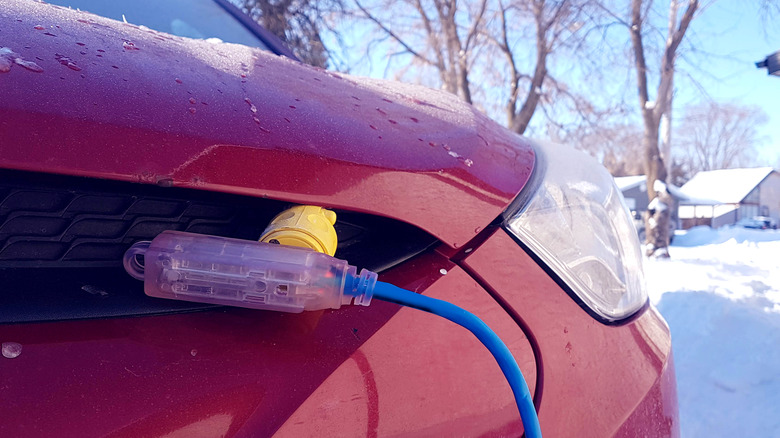Engine Heaters Vs Remote Car Starters: Which Should You Install This Winter?
Winter is fast approaching for folks in the Northern Hemisphere, and the colder months can be rough on vehicles. We have to dig them out after big storms and constantly remove ice and snow from our windshields, roofs, and hoods. Icy and snowy roads are treacherous to drive on, and cold weather can significantly reduce the range of some EVs.
Gas-powered vehicles can have problems getting started in very cold weather. The basic principles of chemistry are at fault here: the reactions in your battery that produce electrons are slowed down, gasoline doesn't vaporize as easily, and oil gets thicker and doesn't circulate as well through your engine. All of these factors contribute to hard starting in extreme cold conditions.
However, you can do a few things to help make your winter morning commute less frustrating. Parking in a heated garage would take care of this issue, but not many of us have this luxury. Two other solutions are remote starters and engine heaters, which function differently but can both help make the cold weather less of an issue for you and your vehicle.
What is a remote starter?
A remote starter is as simple as it sounds: a device that allows you to start your car from outside it, either using a key fob or with your smartphone. Some remote start devices even work with your Apple Watch or Wear OS Android smartwatch. Many newer cars and trucks, including all 2023 model year vehicles from BMW, Dodge, Ford, Honda, and Jeep, can be purchased with remote start right off the lot.
If you have an automatic transmission vehicle from the 2000 model year or later, you can probably also purchase an aftermarket remote starter kit. These kits have a receiver wired into your car's ignition, locking, and brake systems. The receiver will also have a bypass mechanism so your car's alarm isn't triggered when you activate the remote start function.
Some aftermarket systems also tap into your vehicle's OBD-II (On-board diagnostics) system to monitor vehicle status or enable you to remotely adjust climate control settings, allowing you to warm up your vehicle's cabin before you climb inside.
What is an engine heater?
An engine heater is mounted under the hood and connected to a power outlet using an extension cord. There are several varieties of engine heaters, which are implemented differently and warm different fluids or parts of your engine. Some heaters bolt onto the engine and heat the metal from the outside. These heaters are commonly known as block heaters and can be slow and inefficient, as much of the heat is lost to the cold air.
A slightly more efficient solution is an engine warming blanket, which goes over the engine's top and heats the motor from the outside. Sometimes, warming blankets can be attached to the oil pan using magnets or bolts. Oil pan blankets work relatively quickly to heat oil, which has settled in the pan overnight. Other heaters are installed within the hoses in your engine's cooling system, which work to warm your antifreeze mixture while your car sits idle. Another type of engine heater is a dipstick heater, which goes into your oil dipstick tube and heats your engine oil from above.
Engine blankets and dipstick heaters are the simplest to install, but both must be removed before you drive your car. With their semi-permanent mounting (though you do need to unplug them before driving), external block heaters might be the most convenient option, but they are also the least efficient as they have to work through the thick metal of your engine block to get to the fluids inside.
Which option is best?
A remote starter is probably all you need if you're primarily concerned with warming your car's cabin to a comfortable temperature before starting your morning commute. If you have a newer vehicle, chances are this came installed at the factory; consult your owner's manual or call the dealership to check if you have a remote starter on your car. If your car didn't come with a remote starter and you'd like one added, Best Buy includes basic installation free of charge if you purchase a system at one of their stores or via their website. Many car stereo shops also install remote starter systems if you want to shop locally.
If you live in an area that regularly sees temperatures below 10ºF, an engine heater becomes a potentially more valuable — and possibly necessary — investment.
While it's unnecessary to warm up most modern cars before driving them, even in the coldest weather, keeping your engine compartment protected from prolonged exposure to freezing temperatures can prevent cracks in hoses, belts, and the plastic tanks that hold washer fluid and coolant.
Having oil and antifreeze close to operating temperatures when you first start your car will also help those fluids perform at their best, protecting your engine's delicate internal components. If you have an engine heater installed, remember to unplug it before you start driving; you might even want to attach a post-it note or other reminder to your steering wheel or dashboard as a precaution.



